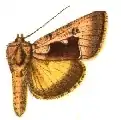Syngrapha diasema
Syngrapha diasema is a moth of the family Noctuidae first described by Jean Baptiste Boisduval in 1829. It is found from northern Fennoscandia to Siberia, across the Arctic and subarctic. In North America, it has been reported across the Arctic and subarctic from Labrador to central Alaska.
| Syngrapha diasema | |
|---|---|
 | |
| Scientific classification | |
| Kingdom: | Animalia |
| Phylum: | Arthropoda |
| Class: | Insecta |
| Order: | Lepidoptera |
| Superfamily: | Noctuoidea |
| Family: | Noctuidae |
| Genus: | Syngrapha |
| Species: | S. diasema |
| Binomial name | |
| Syngrapha diasema (Boisduval, 1829) | |
| Synonyms | |
| |
The wingspan is 30–33 mm. Adults are on wing in July depending on the location. There is one generation per year.
The larvae feed on Betula species (including Betula nana) and Vaccinium and Populus species, as well as Trollius europaeus.
External links
- Anweiler, G. G. & Robinson, E. "Species Details Syngrapha diasema". University of Alberta Museums. E.H. Strickland Entomological Museum. Retrieved November 12, 2020.
This article is issued from Wikipedia. The text is licensed under Creative Commons - Attribution - Sharealike. Additional terms may apply for the media files.